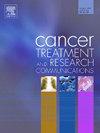酞菁锌光动力疗法通过下调PI3K/AKT/mTOR信号通路增强人肌肉浸润性膀胱癌细胞的顺铂敏感性
IF 2.4
Q3 Medicine
引用次数: 0
摘要
顺铂(CIS)主要作为膀胱癌(BLC)的化疗药物。然而,由于复杂的基因组差异、病理亚型和耐药性,基于cis的化疗在BLC中的总反应仍然令人不满意。在BLC细胞中,PI3K/AKT/mTOR信号通路的激活可促进细胞增殖、侵袭和迁移。此外,由于PI3K/AKT/mTOR上调导致BLC细胞活力增加,BLC细胞可能对基于cis的化疗等抗癌治疗产生耐药性。此外,当与其他治疗方法联合使用时,BLC对CIS的反应可能会增强。其中一种方法是光动力疗法(PDT),其中光敏剂(PS)在靶细胞照射后产生活性氧(ROS)。本研究将PDT和CIS联合应用于EJ138和5637细胞系。采用MTT法测定细胞毒性作用进行评估,并用联合指数(CI)评估协同效应;所有组均观察到协同效应。此外,在联合处理后,细胞活力、细胞迁移和集落形成能力也发生了协同变化。此外,PDT、CIS及其联合用药可下调MMP-9基因的表达,从而损害细胞迁移,特别是在联合用药组。与单独治疗相比,细胞凋亡诱导显著增加。重要的是,CIS与PDT联合可下调PI3K/AKT/mTOR,增强BLC细胞的CIS敏感性。综上所述,CIS和PDT联合治疗对人类肌肉侵袭性膀胱癌细胞(EJ138和5637细胞系)对CIS化疗的致敏作用较高。本文章由计算机程序翻译,如有差异,请以英文原文为准。
Photodynamic therapy with zinc phthalocyanine enhances cisplatin sensitivity of human muscle-invasive bladder cancer cells by downregulation of PI3K/AKT/mTOR signaling pathway
Cisplatin (CIS) is mainly used as a chemotherapeutic drug for bladder cancer (BLC). However, the total response of CIS-based chemotherapy in BLC remains unsatisfactory owing to the complex genomic differences, pathological subtypes, and drug resistance. In BLC cells, activation of the PI3K/AKT/mTOR signaling pathway escalates cell proliferation, invasion, and migration. Furthermore, due to the increase in BLC cell viability resulting from PI3K/AKT/mTOR upregulation, BLC cells may acquire resistance to anti-cancer treatments such as CIS-based chemotherapy. Also, the BLC response to CIS may be enhanced when combined with other therapeutic approaches. One such approach is photodynamic therapy (PDT), where a photosensitizer (PS) generates reactive oxygen species (ROS) after illumination of target cells. In this study, the combination of PDT and CIS was applied to treat EJ138 and 5637 cell lines. Cytotoxic effects were determined by MTT assay for assessment, and synergistic effects were estimated using the Combination Index (CI); synergistic effects were observed in all groups. Also, synergistic changes in cell viability, cell migration, and colony formation ability were observed after combination treatment. Moreover, PDT, CIS, and their combination down-regulated the expression of the MMP-9 gene, which impaired cell migration, especially in combination groups. Apoptosis induction was significantly increased compared to either treatment alone. Importantly, CIS, in combination with PDT, down-regulated the PI3K/AKT/mTOR that augmented the CIS sensitivity of BLC cells. In conclusion, it can be suggested that a combination treatment of CIS and PDT has high effects on sensitizing human muscle-invasive bladder cancer cells (EJ138 and 5637 cell lines) to CIS-based chemotherapy.
求助全文
通过发布文献求助,成功后即可免费获取论文全文。
去求助
来源期刊

Cancer treatment and research communications
Medicine-Oncology
CiteScore
4.30
自引率
0.00%
发文量
148
审稿时长
56 days
期刊介绍:
Cancer Treatment and Research Communications is an international peer-reviewed publication dedicated to providing comprehensive basic, translational, and clinical oncology research. The journal is devoted to articles on detection, diagnosis, prevention, policy, and treatment of cancer and provides a global forum for the nurturing and development of future generations of oncology scientists. Cancer Treatment and Research Communications publishes comprehensive reviews and original studies describing various aspects of basic through clinical research of all tumor types. The journal also accepts clinical studies in oncology, with an emphasis on prospective early phase clinical trials. Specific areas of interest include basic, translational, and clinical research and mechanistic approaches; cancer biology; molecular carcinogenesis; genetics and genomics; stem cell and developmental biology; immunology; molecular and cellular oncology; systems biology; drug sensitivity and resistance; gene and antisense therapy; pathology, markers, and prognostic indicators; chemoprevention strategies; multimodality therapy; cancer policy; and integration of various approaches. Our mission is to be the premier source of relevant information through promoting excellence in research and facilitating the timely translation of that science to health care and clinical practice.
 求助内容:
求助内容: 应助结果提醒方式:
应助结果提醒方式:


